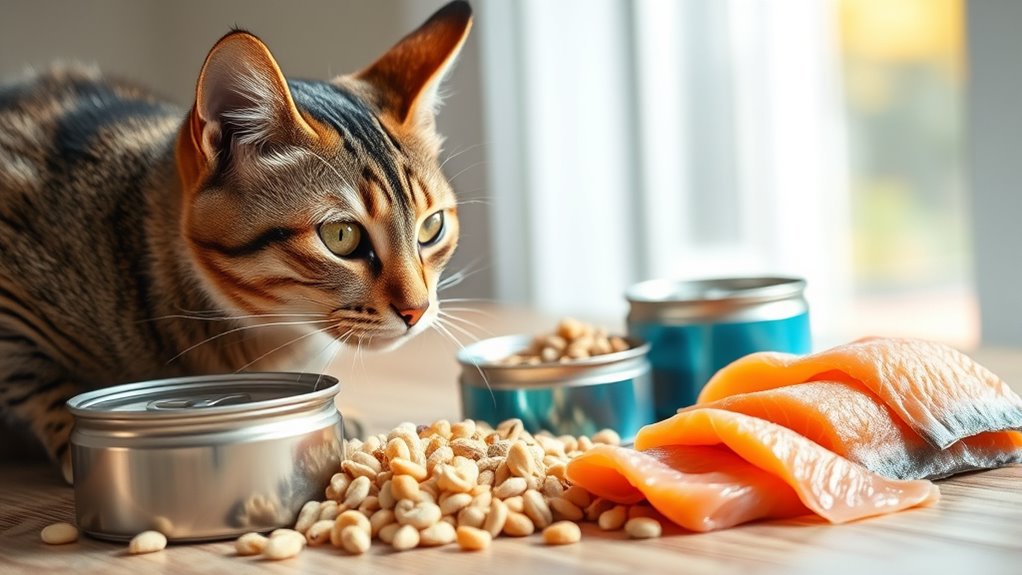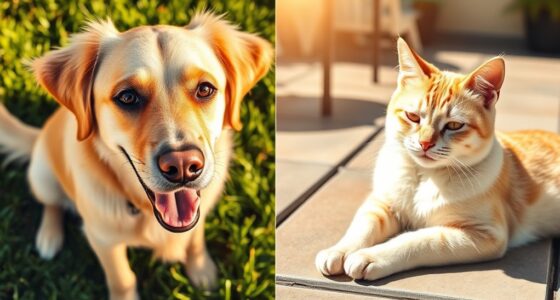To understand your cat’s nutrition needs, focus on providing a balanced, high-quality diet that caters to their obligate carnivore nature. Guarantee they get essential nutrients like taurine, vitamins, and minerals through complete foods meeting AAFCO standards. Follow feeding guidelines based on age, weight, and activity, and monitor their health and weight regularly. Paying attention to these details helps keep your cat happy and healthy—keep exploring to learn even more about ideal feline nutrition.
Key Takeaways
- Cats are obligate carnivores, requiring animal-based proteins and essential nutrients like taurine, arachidonic acid, and vitamin A.
- Follow feeding guidelines based on your cat’s age, weight, and activity level, adjusting portions as needed.
- Provide a balanced diet with high-quality, complete foods that meet AAFCO standards to prevent nutritional deficiencies.
- Feed your cat consistently, typically twice daily for adults, and monitor for signs of health issues or nutritional gaps.
- Prioritize long-term health by managing portions, routines, and selecting diets that support immunity, organ health, and overall well-being.

Understanding your cat’s nutrition needs is essential for keeping them healthy and happy. When you’re selecting food and creating a feeding routine, it’s important to follow proper feeding guidelines to ensure your feline gets all the nutrients they require. Cats are obligate carnivores, which means they need a diet rich in animal-based proteins and specific nutrients like taurine, arachidonic acid, and vitamin A. Ignoring these needs can lead to nutritional deficiencies that impact their overall health, causing issues like poor coat condition, weak immune function, or even serious organ problems.
Proper feline nutrition is vital; ensure balanced diets rich in animal proteins to maintain health and prevent deficiencies.
To start, you should always read the feeding guidelines on the cat food packaging. These are designed to provide a general recommendation based on your cat’s age, weight, and activity level. But keep in mind, every cat is unique. Some may require more or less food depending on their metabolism and health status. Regularly monitoring your cat’s weight and body condition helps you adjust portion sizes accordingly. Overfeeding can lead to obesity, which increases the risk of diabetes, joint issues, and other health complications. Conversely, underfeeding can result in nutritional deficiencies, leaving your cat malnourished and vulnerable to illnesses.
Providing a balanced diet means giving your cat a variety of nutrients, but it’s crucial to avoid deficiencies. Nutritional deficiencies can develop if your cat isn’t receiving enough essential nutrients, which can happen if their diet is too limited or if they’re eating low-quality food. For example, a lack of taurine can cause serious heart and eye problems, while insufficient vitamins and minerals can weaken their immune system. That’s why choosing high-quality, complete cat foods that meet AAFCO standards is vital. These foods are formulated to provide all the necessary nutrients in the right proportions, reducing the risk of deficiencies.
Feeding guidelines aren’t just about quantity—they also guide you on how often to feed your cat. Most adult cats do well with two meals a day, but kittens, seniors, or cats with special health issues might need different schedules. Always observe your cat’s behavior and health, and consult your veterinarian if you notice signs of nutritional deficiencies like dull coat, lethargy, or digestive issues. Remember, consistent feeding routines and appropriate portion sizes help your cat maintain a healthy weight and ensure they receive all the nutrients they need for a vibrant, happy life. Proper diet balance and attention to their unique needs are key to supporting long-term health and well-being. By paying close attention to these details, you’re setting your feline friend up for long-term health and well-being.
Frequently Asked Questions
How Often Should I Feed My Cat Each Day?
You should establish a consistent feeding schedule for your cat, usually feeding them two to three times a day. This helps with portion control and prevents overeating. Stick to measured portions based on your cat’s age, weight, and activity level. Regular mealtimes also support digestion and behavior. Adjust the schedule if needed, but maintaining a routine keeps your cat healthy and happy.
Are Homemade Diets Suitable for Cats’ Nutrition?
Think of homemade recipes as crafting a fine potion—you need the right ingredients. While they can be suitable, you must guarantee a nutritional balance to meet your cat’s needs. Without proper guidance, your DIY meals risk missing essential nutrients. It’s best to consult a veterinarian or pet nutritionist before preparing homemade diets, so you can confidently provide a safe, wholesome meal that keeps your feline happy and healthy.
What Are Signs of Nutritional Deficiencies in Cats?
You should watch for signs of nutritional deficiencies in your cat, like vitamin deficiencies and hair loss. If your cat starts shedding excessively, has dull or patchy fur, or shows changes in energy or appetite, these could indicate deficiencies. Keep an eye out for skin issues, lethargy, or gastrointestinal problems too. Regular vet visits and a balanced diet help prevent these issues, ensuring your cat stays healthy and vibrant.
Can Cats Eat Human Food Safely?
Careful consideration keeps your cat’s cuisine safe. While some human foods, like cooked meats or certain veggies, may seem tempting, cat food safety is essential. Many human foods pose risks, including toxic ingredients or harmful spices. You shouldn’t serve your feline friend leftovers or treats without checking. Always prioritize pet-specific products, and consult your vet about what’s safe. Prevent problems by prioritizing proper pet nourishment over potentially perilous human plate portions.
How Does a Cat’S Age Affect Its Dietary Needs?
As your cat ages, their dietary needs change due to age-related changes like decreased activity and health issues. You should make dietary adjustments by offering easier-to-digest foods, ensuring proper nutrient balance, and possibly adding supplements recommended by your vet. Younger cats require more energy-dense diets, while older cats benefit from specialized formulas that support joint health and overall wellbeing. Regular vet visits help tailor these adjustments effectively.
Conclusion
Now that you understand your cat’s unique nutritional needs, you’re like a skilled gardener tending to a delicate plant. With each meal, you nurture their health and happiness, watching them thrive and blossom. Remember, your attention and care are the sunlight and water that keep your feline friend vibrant and strong. By providing the right balance, you’re crafting a symphony of wellness, where every note sings of love and commitment.









